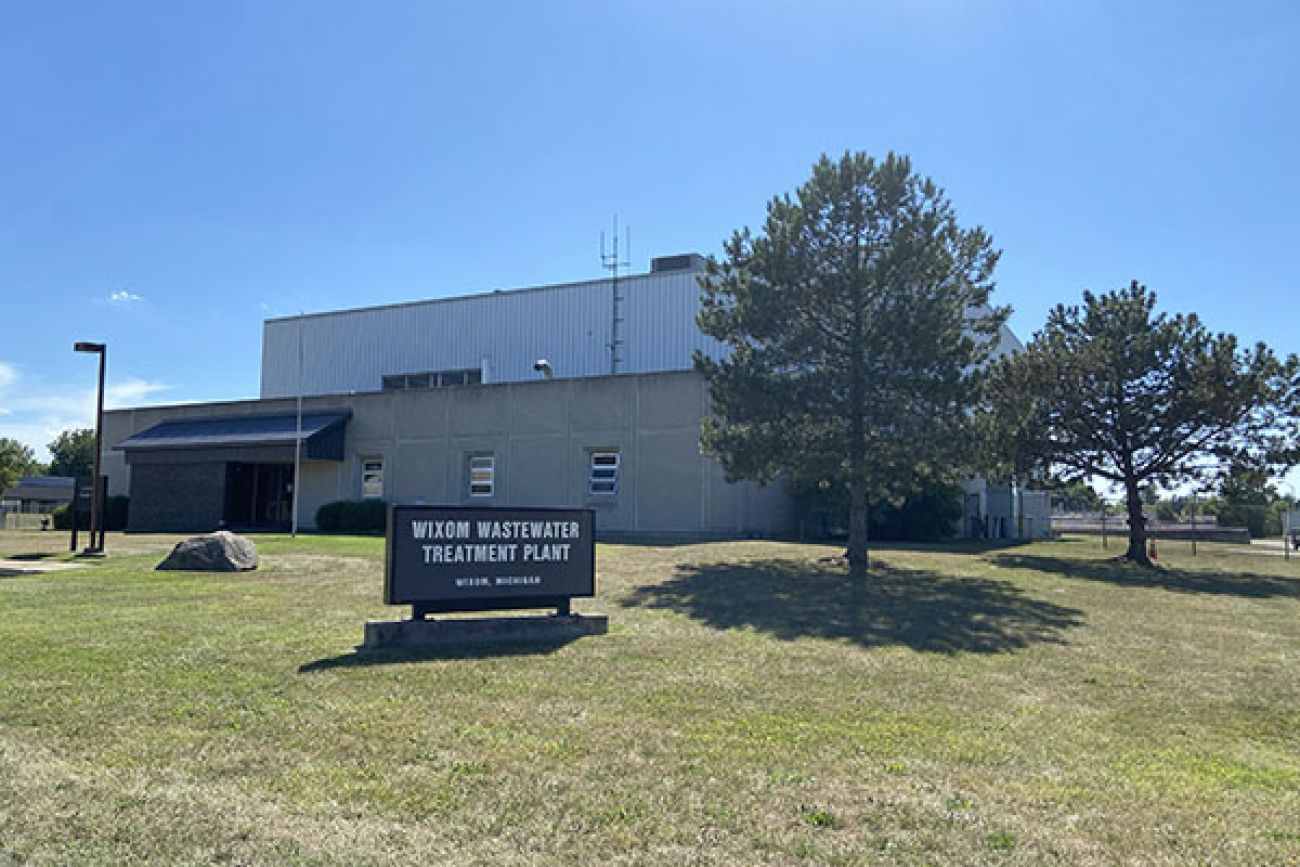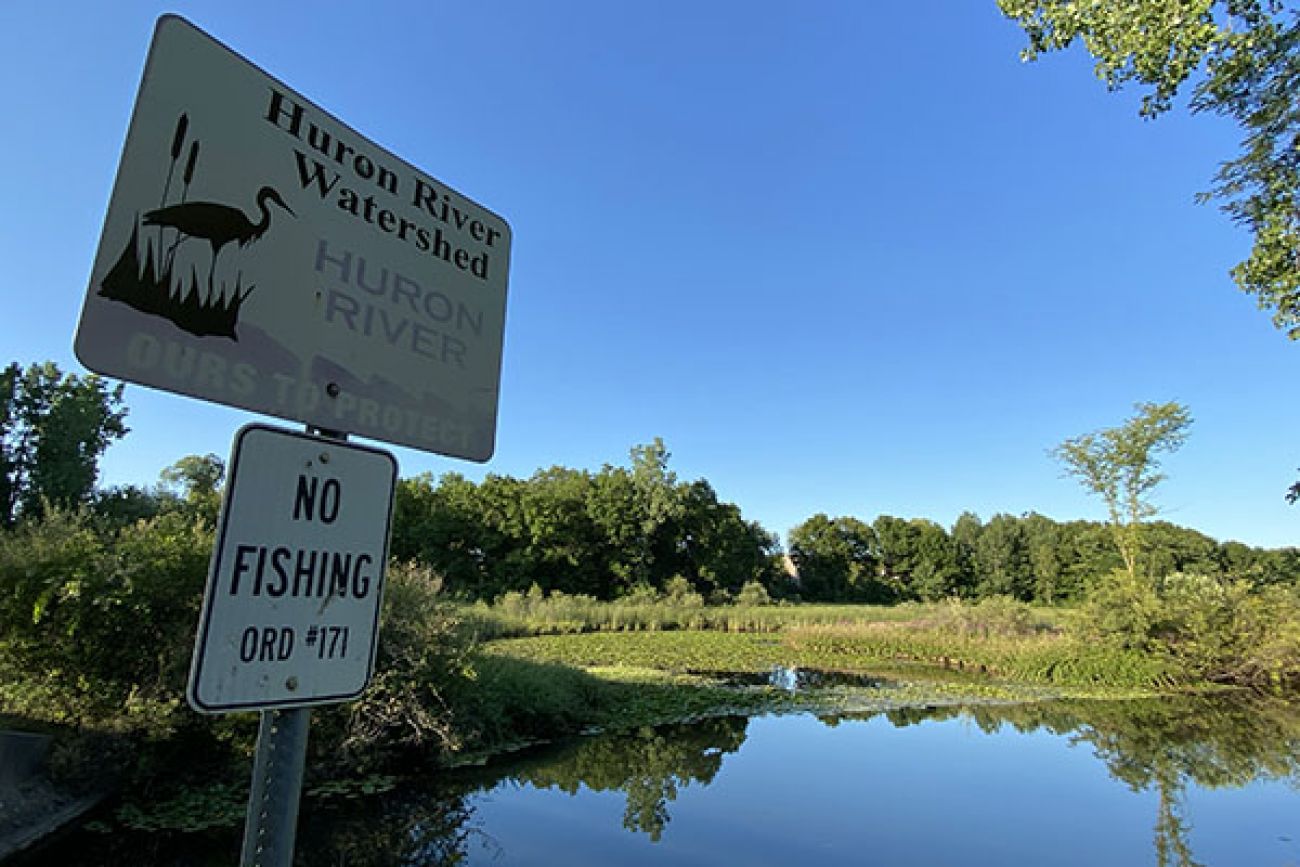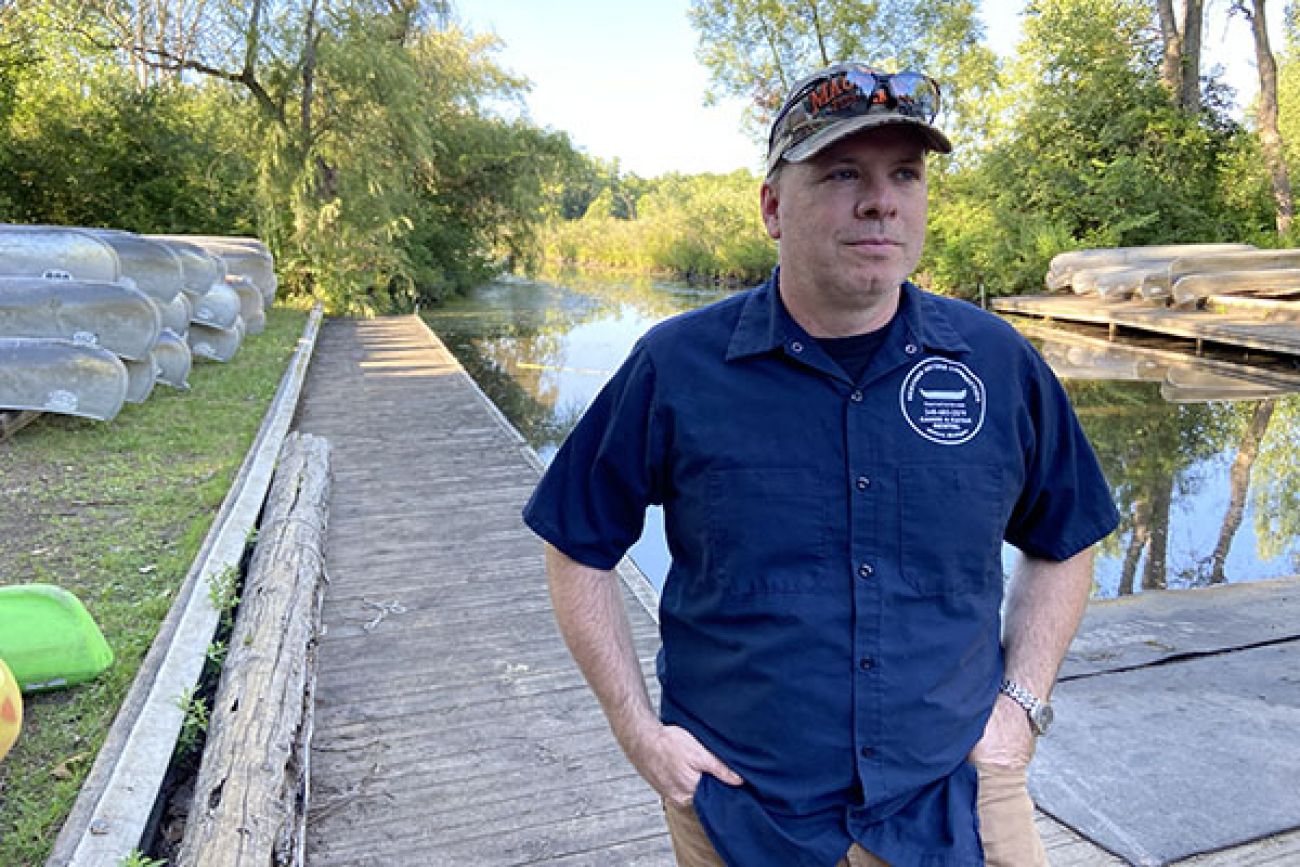
By Kelly House, Bridge Michigan
The Great Lakes News Collaborative includes Bridge Michigan; Circle of Blue; Great Lakes Now at Detroit Public Television; and Michigan Radio, Michigan’s NPR News Leader; who work together to bring audiences news and information about the impact of climate change, pollution, and aging infrastructure on the Great Lakes and drinking water. This independent journalism is supported by the Charles Stewart Mott Foundation. Find all the work HERE.
- Anger is rising against a Wixom company that has now twice fouled the Huron River with toxic chemicals
- Tribar Manufacturing has temporarily halted operations after a cease-and-desist letter from the city
- Tribar was linked to PFAS contamination in the river in 2018 that led to do-not-eat fish advisories
Daniel Brown is furious.
It’s bad enough, said Brown, a watershed planner for the Huron River Watershed Council, that after decades of work by area communities to secure the river’s reputation as one of the state’s cleanest urban waterways, people can no longer eat fish in many areas due to PFAS contamination traced to a Tribar Manufacturing facility in Wixom.
Now, the automotive supplier’s latest transgression — a multi-thousand-gallon release of liquid containing carcinogenic hexavalent chromium — has left some of the river’s most beloved upstream reaches untouchable.
“It’s been devastating to see so many hits that just keep coming,” Brown said. “It really feels like we’re being kicked while we’re down.”
On a hot summer day when residents normally would be playing on the beach at Kensington Metropark or paddling alongside herons and turtles in the wild reaches upstream of Milford, the riverbanks were barricaded with orange fencing and plastered with printouts warning not to touch the water.
“It’s eerie,” Brown said.
Scientists with the Michigan Department of Environment, Great Lakes and Energy on Wednesday were racing to identify the extent and location of contamination, a day after state health officials warned people to avoid “all contact” with the section from North Wixom Road in Oakland County to Kensington Road in Livingston County.
Regulators said Tribar Manufacturing released thousands of gallons of a liquid containing 5 percent hexavalent chromium into the Wixom sewers beginning as early as Saturday. The company discovered the release Monday morning, and reported the incident to the Michigan Department of Environment, Great Lakes and Energy more than seven hours later, said EGLE spokesperson Hugh McDiarmid.
By then, the container housing the chromium mixture was empty, its contents flushed through city sewers to the Wixom wastewater treatment plant, which discharges into the Huron River tributary of Norton Creek.

Staff at the Wixom wastewater plant attempted to contain sewage on-site after learning of a hexavalent chromium release from a nearby Tribar Manufacturing facility. But the plant’s tanks and ditches quickly filled, forcing staff to resume sending effluent into Norton Creek (Bridge photo by Kelly House)
Tribar, the company that the state has identified as responsible for the spill, has remained publicly silent about how it happened, and why it waited hours to report the issue to state regulators.
So far, the results of two water samples taken Tuesday near the Huron River’s confluence with Norton Creek have detected no hexavalent chromium. But that’s not enough information to draw conclusions about the river’s safety, said Kory Groetsch, environmental public health director for the Michigan Department of Health and Human Services.
As regulators await more results to get a better handle on the pollution’s spread, “we’re hoping for the best but preparing for the worst,” Groetsch said.
EGLE scientists sampled nine more locations Wednesday, with results expected Thursday. And the agency is crafting plans for additional testing. The state is also inspecting the Tribar facility, hoping to better understand what caused the spill and exactly how much liquid was released.
“EGLE is investigating all circumstances surrounding this release, and we haven’t ruled out anything yet,” agency spokesperson Hugh McDiarmid said.
Hexavalent chromium, also known as chromium-6, is a toxic compound and a large body of research has linked chromium compounds to lung cancer and a host of other health issues. Though humans can tolerate some forms of it in small amounts, the compound is particularly toxic when breathed, ingested or touched.
Tribar was using the hexavalent chromium to chrome-plate auto products at the plant on Alpha Drive, McDiarmid said. The company’s website lists a host of customers including Ford, General Motors and Rivian, but it’s unclear which companies purchase hexavalent chromium-containing products from Tribar.
In Wixom, city officials said they are trying to get a handle on how severely the release contaminated the wastewater treatment plant, and how much it will cost to clean up.
Wixom City Manager Steven Brown said Tribar has ceased operations at the plant after the city issued a cease and desist letter that allows the facility to send only typical household waste through city sewers.
After learning of the contamination Monday afternoon, staff at the city’s wastewater treatment plant scrambled to divert as much sewage as possible into on-site holding tanks and containment ditches in an attempt to keep it out of Norton Creek, Steven Brown, the city manager, told Bridge Michigan.
But those containment vessels quickly filled, forcing staff to resume sending the water down Norton Creek. It’s unknown how much chromium may have reached the creek — and then the Huron River — before city officials were alerted to the spill.
Brown said the city is expecting to incur costs to clean up contamination at the wastewater facility, and will be pursuing Tribar for reimbursement.
“It’s disappointing and angering,” he said.
Until more water samples come back, it’s impossible to know what, if any, health risks river users may experience if they recently swam or fished in the suspected contamination zone.
But “people should be aware,” said Groetsch of MDHHS, and avoid the water in areas subject to the state no-contact advisory.
Groetsch said the most likely possible consequence for someone who came into contact with contaminated water would be a skin reaction. Michigan health officials are directing people with questions about hexavalent chromium, potential health effects or exposures to call the MI Toxic Hotline at 800-648-6942.
Groundwater pollution is not a concern, Groetsch said, and state officials have no plans to test wells.
A history of problems
The chromium release is the latest in a string of pollution problems linked to Tribar, a company with plants in Wixom and Howell that manufactures decorative trim, grilles, door seals and other automotive components.
State investigators concluded in 2018 that PFAS-tainted wastewater from another Tribar plant, on Wixom’s Beck Road, was the main culprit behind PFAS contamination in the Huron River.

The Huron River’s upstream reaches flow through forested wetlands frequented by herons, turtles and other fish and wildlife. Rife with public parks, they’re also popular among anglers, paddlers and swimmers. (Bridge photo by Kelly House)
That contamination was so severe, it resulted in widespread “do not eat” fish consumption advisories that remain in place today in the Huron and nearby lakes, ponds and streams.
Tribar faced no state violations or fines stemming from those wastewater releases. At the time, Michigan was among many states that lacked regulations prohibiting such releases, and Tribar had phased out PFAS use at the facility years earlier.
Tribar installed filters at the plant to strip PFAS from its wastewater, but its contamination troubles continued as PFAS-tainted stormwater sloughed off the property and into the Rouge River watershed. EGLE directed Tribar in September 2021 to “take immediate action” to address the problem.
Tribar’s Plant 5, the facility responsible for this week’s hexavalent chromium spill, has no record of previous state water pollution violations, EGLE spokesperson Scott Dean said.
But he said the city of Wixom cited the facility over PFOS-tainted wastewater discharges in November 2020, prompting Tribar to install a filtration unit at the plant last fall. It’s unclear how those discharges occurred, as the plant was built after Tribar stopped using PFOS fume suppressants at its facilities.
A call for consequences
In Ann Arbor, which draws drinking water from the Huron, city officials on Wednesday were monitoring the chromium release and crafting contingency plans in case the plume reaches the city’s water intake, said Brian Steglitz, the city’s interim public services area administrator and water treatment plant manager.
At the rate of the river’s flow, state regulators say, that could take weeks.
This is familiar territory for Ann Arbor. The spent $1.5 million on retrofits to remove PFAS from its source water after state regulators discovered the earlier contamination linked to Tribar. Maintenance costs continue at about $250,000 yearly.
For now, Steglitz said, city officials are focused on spill response. But “we will consider additional actions that are warranted to protect our water supply from contamination threats at the appropriate time.”
Following this week’s spill, environmentalists and Huron River users called for regulators to impose stiffer consequences on Tribar this time around, and urged lawmakers to strengthen Michigan’s environmental laws to better prevent future spills.
“We need to know exactly what happened, exactly how this happened,” the watershed council’s Daniel Brown said. “But most importantly, things like this shouldn’t happen.”
Brown said the river’s health had been improving since landmark federal environmental laws in the 1970s tamped down on industrial pollution. But the rollback of Michigan’s polluter pay laws in the mid-1990s mean “in a lot of ways we’ve really backflipped from that.”
The spill comes as national environmental groups push the U.S. Environmental Protection Agency to adopt an enforceable drinking water standard for hexavalent chromium. The federal drinking water limit for total chromium is 100 parts-per-billion, but that includes trivalent chromium, a far safer compound.

Fed up with impacts to his canoe livery business resulting from the same company’s repeated toxic releases, Bruce Heavner said he’s considering legal action against Tribar Manufacturing. (Bridge photo by Kelly House)
“We absolutely should have a drinking water standard for hexavalent,” said Tasha Stoiber, a senior scientist with the national Environmental Working Group, a Washington-based environmental research nonprofit.
In absence of federal action, California this year proposed its own hexavalent chromium drinking water standard of 10 parts per billion. The state is also advancing rules to phase out the compound’s use in chrome plating.
Beth Gotthelf, vice president and general counsel to the Michigan chapter of the National Association of Surface Finishers, said the industry has been striving “for many years” to phase out the toxic compound in favor of safer trivalent chromium.
But “it’s not easy,” she said, particularly in the defense and automotive arenas.
Hexavalent chromium is favored for its corrosion resistance, affordability and availability.
Tribar is not a member of the Michigan chapter of the National Association of Surface Finishers, Gotthelf said, so the association knows little about its use of hexavalent chromium. Asked whether the spill calls for stiffer regulations against chrome platers’ use of the substance, Gotthelf was hesitant to answer.
“We don’t know the facts of this case,” she said.
Brown, the Huron River advocate, said he feels differently after watching the Huron River endure two simultaneous public health threats, both caused by dangerous chemicals for which the metal plating industry has safer substitutes.
“We need to really evaluate how and why these things are being used,” he said, “and we need to be banning non-essential uses.”
Catch more news at Great Lakes Now:
More Canada geese — and their poop — make Michigan home. Blame the heat.
Researchers race to understand what lies beneath the Great Lakes
Featured image: Caution tape and an “avoid contact” notice now join the long-standing “do not eat the fish” sign at Milford’s Central Park, after a hexavalent chromium release added new contamination to a river already plagued by PFAS. (Bridge photo by Kelly House)




